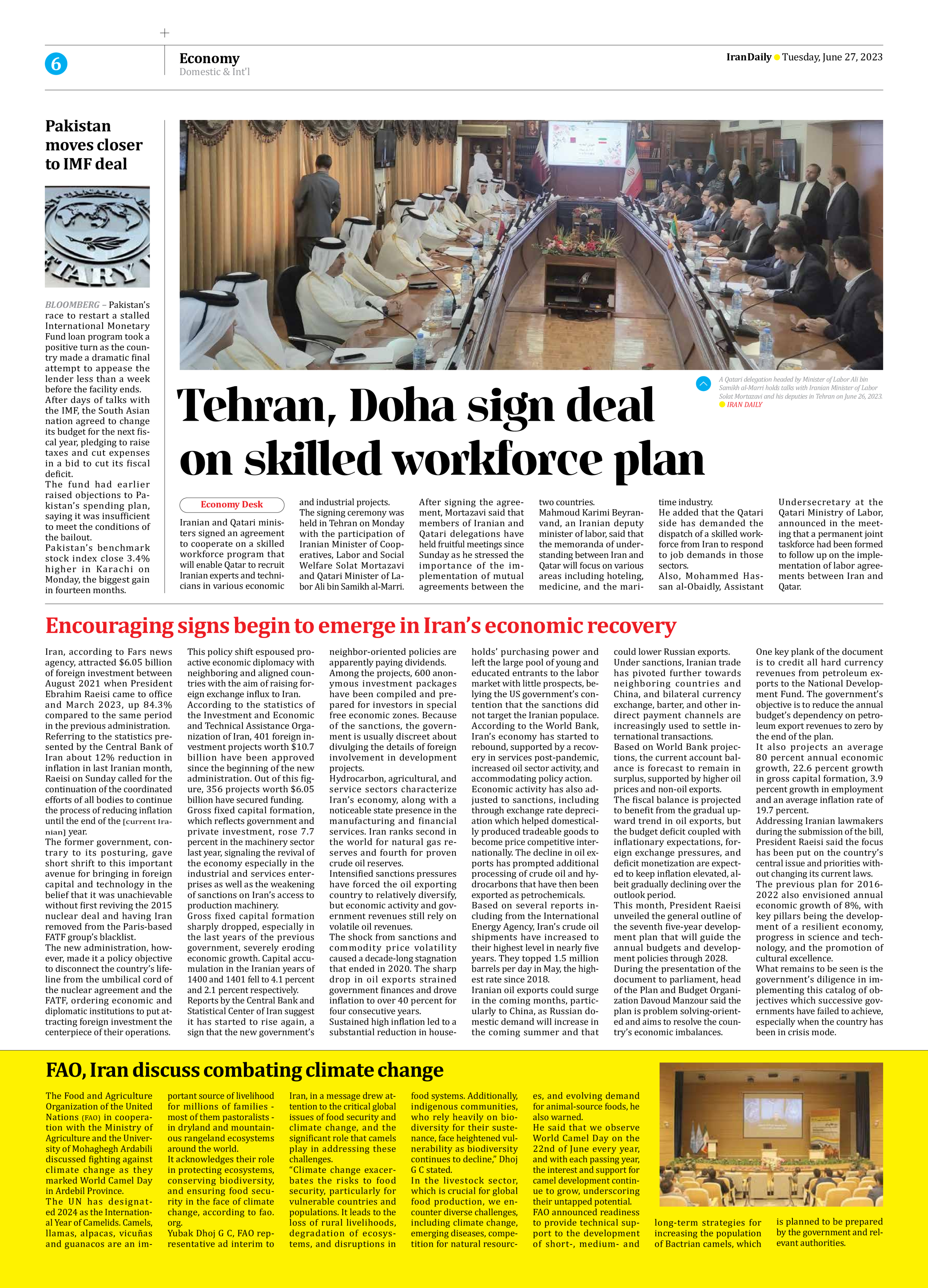
Encouraging signs begin to emerge in Iran’s economic recovery
Iran, according to Fars news agency, attracted $6.05 billion of foreign investment between August 2021 when President Ebrahim Raeisi came to office and March 2023, up 84.3% compared to the same period in the previous administration.
Referring to the statistics presented by the Central Bank of Iran about 12% reduction in inflation in last Iranian month, Raeisi on Sunday called for the continuation of the coordinated efforts of all bodies to continue the process of reducing inflation until the end of the [current Iranian] year.
The former government, contrary to its posturing, gave short shrift to this important avenue for bringing in foreign capital and technology in the belief that it was unachievable without first reviving the 2015 nuclear deal and having Iran removed from the Paris-based FATF group’s blacklist.
The new administration, however, made it a policy objective to disconnect the country’s lifeline from the umbilical cord of the nuclear agreement and the FATF, ordering economic and diplomatic institutions to put attracting foreign investment the centerpiece of their operations.
This policy shift espoused proactive economic diplomacy with neighboring and aligned countries with the aim of raising foreign exchange influx to Iran.
According to the statistics of the Investment and Economic and Technical Assistance Organization of Iran, 401 foreign investment projects worth $10.7 billion have been approved since the beginning of the new administration. Out of this figure, 356 projects worth $6.05 billion have secured funding.
Gross fixed capital formation, which reflects government and private investment, rose 7.7 percent in the machinery sector last year, signaling the revival of the economy especially in the industrial and services enterprises as well as the weakening of sanctions on Iran’s access to production machinery.
Gross fixed capital formation sharply dropped, especially in the last years of the previous government, severely eroding economic growth. Capital accumulation in the Iranian years of 1400 and 1401 fell to 4.1 percent and 2.1 percent respectively.
Reports by the Central Bank and Statistical Center of Iran suggest it has started to rise again, a sign that the new government’s neighbor-oriented policies are apparently paying dividends.
Among the projects, 600 anonymous investment packages have been compiled and prepared for investors in special free economic zones. Because of the sanctions, the government is usually discreet about divulging the details of foreign involvement in development projects.
Hydrocarbon, agricultural, and service sectors characterize Iran’s economy, along with a noticeable state presence in the manufacturing and financial services. Iran ranks second in the world for natural gas reserves and fourth for proven crude oil reserves.
Intensified sanctions pressures have forced the oil exporting country to relatively diversify, but economic activity and government revenues still rely on volatile oil revenues.
The shock from sanctions and commodity price volatility caused a decade-long stagnation that ended in 2020. The sharp drop in oil exports strained government finances and drove inflation to over 40 percent for four consecutive years.
Sustained high inflation led to a substantial reduction in households’ purchasing power and left the large pool of young and educated entrants to the labor market with little prospects, belying the US government’s contention that the sanctions did not target the Iranian populace.
According to the World Bank, Iran’s economy has started to rebound, supported by a recovery in services post-pandemic, increased oil sector activity, and accommodating policy action.
Economic activity has also adjusted to sanctions, including through exchange rate depreciation which helped domestically produced tradeable goods to become price competitive internationally. The decline in oil exports has prompted additional processing of crude oil and hydrocarbons that have then been exported as petrochemicals.
Based on several reports including from the International Energy Agency, Iran’s crude oil shipments have increased to their highest level in nearly five years. They topped 1.5 million barrels per day in May, the highest rate since 2018.
Iranian oil exports could surge in the coming months, particularly to China, as Russian domestic demand will increase in the coming summer and that could lower Russian exports.
Under sanctions, Iranian trade has pivoted further towards neighboring countries and China, and bilateral currency exchange, barter, and other indirect payment channels are increasingly used to settle international transactions.
Based on World Bank projections, the current account balance is forecast to remain in surplus, supported by higher oil prices and non-oil exports.
The fiscal balance is projected to benefit from the gradual upward trend in oil exports, but the budget deficit coupled with inflationary expectations, foreign exchange pressures, and deficit monetization are expected to keep inflation elevated, albeit gradually declining over the outlook period.
This month, President Raeisi unveiled the general outline of the seventh five-year development plan that will guide the annual budgets and development policies through 2028.
During the presentation of the document to parliament, head of the Plan and Budget Organization Davoud Manzour said the plan is problem solving-oriented and aims to resolve the country’s economic imbalances.
One key plank of the document is to credit all hard currency revenues from petroleum exports to the National Development Fund. The government’s objective is to reduce the annual budget’s dependency on petroleum export revenues to zero by the end of the plan.
It also projects an average 80 percent annual economic growth, 22.6 percent growth in gross capital formation, 3.9 percent growth in employment and an average inflation rate of 19.7 percent.
Addressing Iranian lawmakers during the submission of the bill, President Raeisi said the focus has been put on the country’s central issue and priorities without changing its current laws.
The previous plan for 2016-2022 also envisioned annual economic growth of 8%, with key pillars being the development of a resilient economy, progress in science and technology, and the promotion of cultural excellence.
What remains to be seen is the government’s diligence in implementing this catalog of objectives which successive governments have failed to achieve, especially when the country has been in crisis mode.







